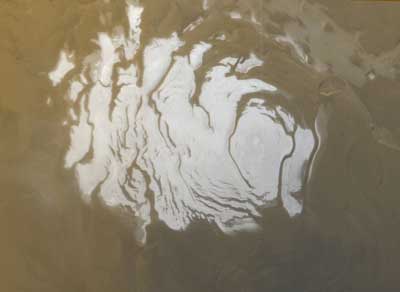
Global Surveyor sees seasonal changes on Mars
NASA/JPL/MSSS NEWS RELEASE
Posted: April 28, 2000
New images of the Martian south polar cap and a crater in
the Northern Hemisphere show seasonal changes taking place in
each region as seen from NASA's Mars Global Surveyor spacecraft,
currently orbiting Mars.

South Polar Cap. Photo: NASA/JPL/MSSS
|
This is the south polar cap of Mars as it appeared to the Mars Global Surveyor (MGS) Mars Orbiter Camera (MOC) on April 17. In winter and early spring, this entire scene would be covered by frost. In summer, the cap shrinks to its minimum size, as shown here. Even though it is summer, observations made by the Viking orbiters in the 1970s showed that the south polar cap remains cold enough that the polar frost (seen here as white) consists of carbon dioxide. Carbon dioxide freezes at temperatures around -125 degrees C (-193 degrees F). Mid-summer afternoon sunlight illuminates this scene from the upper left from about 11.2 degrees above the horizon. Soon the cap will experience sunsets; by June 2000, this pole will be in autumn, and the area covered by frost will begin to grow. Winter will return to the south polar region in December 2000. The polar cap from left to right is about 420 km (260 mi) across.

The Frosty Rims of Lomonosov Crater in Winter. Photo: NASA/JPL/MSSS
|
It is still winter in the northern hemisphere of Mars. On April 20, the Mars Orbiter Camera (MOC) onboard Mars Global Sureyor (MGS) captured this view of a chilly Lomonosov Crater. The rims of the crater appear white because they are covered with wintertime frost. A dark patch just right of center on the crater floor is a sand dune field. Both low-lying ground fogs (fuzzy, patchy areas around the lower perimeter of the crater) and higher cloud layers (fuzzy white arcs seen within the crater and towards the upper right) obscure much of the surface. The sun, only 12 degrees above the horizon, bathes the scene in a reddish-brown hue. Lomonosov Crater is about 150 km (93 mi) across and located on the martian northern plains at 64.8 degrees N, 8.8 degrees W. The crater is named for the 18th Century Russian chemist, Mikhail V. Lomonosov (1741-1765). Spring will arrive in the martian northern hemisphere around June 1, 2000, and summer will come in December 2000. Sunlight illuminates this scene from the lower left.
Malin Space Science Systems and the California Institute of Technology built the MOC using spare hardware from the Mars Observer mission. MSSS operates the camera from its facilities in San Diego, CA. The Jet Propulsion Laboratory's Mars Surveyor Operations Project operates the Mars Global Surveyor spacecraft with its industrial partner, Lockheed Martin Astronautics, from facilities in Pasadena, CA and Denver, CO.
Mars Global Surveyor is managed by the Jet Propulsion Laboratory for NASA's Office of Space Science, Washington, DC. JPL is a division of the California Institute of Technology in Pasadena.

|
 |
 |
 |

NewsAlert
Sign up for Astronomy Now's NewsAlert service and have the latest news in astronomy and space e-mailed directly to your desktop (free of charge).



|

